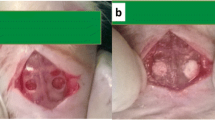Abstract
Resorbable ceramics such as biphasic calcium phosphates (BCP) are ideal candidates as drug delivery systems. The BCP ceramic is based on the optimum balance of the most stable hydroxyapatite (HA) phase and more soluble tricalcium phosphate phase (TCP). Doxycycline is a broad-spectrum antibiotic used for the local treatment of periodontitis. The development of BCP microspheres and its release kinetics with doxycycline have been studied. The BCP ceramic powder were prepared by microwave processing and characterised by X-ray diffraction (XRD) and Fourier transform infrared spectroscopy (FT-IR) methods. The BCP microspheres were formed by liquid immiscibility effect using gelatin and paraffin oil. Difference in the morphology of the microspheres as a function of gelatin content has been observed. Scanning electron microscope indicated spherical and porous morphology of the microspheres. Drug incorporation was studied at varying pH and the pH 7 was found to be optimal for drug loading. Release pattern tend to depend on the morphology of BCP microspheres. An optimum release of 80% drug has been observed for BCP microsphere with HA:TCP = 65:35 ratio. The surface area measurement results also correlate with drug release obtained.














Similar content being viewed by others
References
A. KRAJEWSKI, M. KIRSCH, A. RAVAGLIOLI, M. MAZZOCCHI in Proceedings of the 6th International Meeting and Seminar on Ceramics, Cells and Tissues. Faenza, 2000, edited by A. Ravaglioli, A.Krajewski p. 3.
L. DI SILVIO and W. BONFIELD, J. Mater. Sci: Mater. Med. 10 (1999) 653
W. PAUL and C. P. SHARMA, J. Biomaterial. Appl. 17 (2003) 253
V. S. KOMLEV, S. M. BARINOV and E. V. KOPLIK, Biomaterials 23 (2002) 3449
S. KIMAKHE, S. BOHIC, C. LAROSSE, A. REYNAUD, P. PILET, B. GIUMELLI, D. HEYMANN and G. DACULSI, J. Biomed. Mater. Res. 47 (1999) 18
M. TREANT, J. GUICHEUX, G. GRIMANDS, M. LEROY and G. DACULSI, Biomaterials 18 (1997) 141
L. OBADIA, G. AMADOR, G. DACULSI and J. M. BOULDER, Biomaterials 24 (2003) 1265
L. E. BROMBERG, V. M. BRAMAN, D. M. ROTHSTEIN, P. SPACCIAPOLI, S. M. O’CONNOR, E. J. NELSON, D. K. BUXTON, M. S. TONETTI and P. M. FRIDEN, J. Control. Rel. 68 (2000) 63
L. E. BROMBERG, D. K. BUXTON and P. M. FRIDEN, J. Control. Rel. 71 (2001) 251
G. DACULSI, Biomaterials 19 (1998) 1473
G. DACULSI, N. PASSUTTI, S. MARTIN, C. DEUDON, R. Z. LEGEROS and S. RATHER, J. Biomed. Mater. Sci. 24 (1990) 1623
T. S. SAMPATH KUMAR, I. MANJUBALA and J. GUNASEKARAN, Biomaterials 21 (2000) 272
I. MANJUBALA and M. SIVAKUMAR, Mater. Chem. Phys. 71 (2001) 379
MADHANA. SUNDER, N. RAMESH BABU, SUNITA PREM VICTOR, K. RAMKUMAR and T. S. SAMPATH KUMAR, Trends Biomat. Artif. Organs. 18 (2005) 213
D. M. LIN, S. KALACHANDRA, J. VALIAPARAMBIL and S. OFFENBACHER, Dental Mater. 19 (2003) 589
M. STIGER, J. BEZEMER, K. DE GROOT and P. LAYROLLE, J. Control. Rel. 99 (2004) 127
Author information
Authors and Affiliations
Corresponding author
Rights and permissions
About this article
Cite this article
Victor, S.P., Kumar, T.S.S. BCP ceramic microspheres as drug delivery carriers: synthesis, characterisation and doxycycline release. J Mater Sci: Mater Med 19, 283–290 (2008). https://doi.org/10.1007/s10856-006-0044-7
Received:
Accepted:
Published:
Issue Date:
DOI: https://doi.org/10.1007/s10856-006-0044-7




